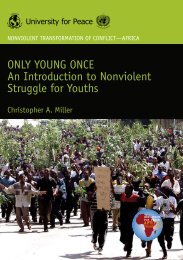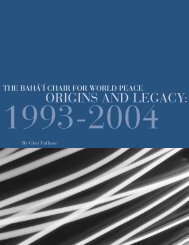environmental degradation as a cause of conflict in - Steiner Graphics
environmental degradation as a cause of conflict in - Steiner Graphics
environmental degradation as a cause of conflict in - Steiner Graphics
Create successful ePaper yourself
Turn your PDF publications into a flip-book with our unique Google optimized e-Paper software.
valuable gifts with their counterparts, establish<strong>in</strong>g friendship ties with one anotherand forbidd<strong>in</strong>g their followers from abus<strong>in</strong>g others by call<strong>in</strong>g them names or <strong>in</strong>sult<strong>in</strong>gthem by referr<strong>in</strong>g to their demean<strong>in</strong>g tribal orig<strong>in</strong>) (<strong>in</strong>terview<strong>in</strong>g Al-B<strong>as</strong>har,July 2003).Tribal FestivalsOne <strong>of</strong> the important peacebuild<strong>in</strong>g <strong>in</strong>stitutions that the colonial government established<strong>in</strong> Darfur w<strong>as</strong> the tribal festivals. Such festivals were arranged periodically.Different tribal groups would take part <strong>in</strong> what w<strong>as</strong> called arda – i.e. procession– whereby tribal horsemen marched <strong>in</strong> front <strong>of</strong> crowds <strong>of</strong> spectators, to demonstratethe relative sizes and well-be<strong>in</strong>g <strong>of</strong> their rid<strong>in</strong>g animals (chiefly horses), their armamentsand their preparedness for defend<strong>in</strong>g their communities, if need be. Thearda w<strong>as</strong> meant to serve several purposes: Firstly, to deter thieves, robbers and<strong>in</strong>vaders <strong>in</strong> general. Secondly, the tribal festivals were to create occ<strong>as</strong>ions <strong>of</strong> publicenterta<strong>in</strong>ment, at a time when means <strong>of</strong> public enterta<strong>in</strong>ment (such <strong>as</strong> the c<strong>in</strong>ema)had not yet been <strong>in</strong>troduced. Thirdly, and more importantly, tribal festivals wereocc<strong>as</strong>ions for tribal leaders to meet and solve <strong>in</strong>ter-group <strong>conflict</strong>s (by form<strong>in</strong>gjo<strong>in</strong>t courts).Follow<strong>in</strong>g the arda, horsemen would go back to their homelands and leave theirleaders to get together and solve tribal problems. They would review the implementation<strong>of</strong> old decisions and look <strong>in</strong>to fresh problems. When the festival w<strong>as</strong> held <strong>in</strong>Nyala, the capital town <strong>of</strong> the district, the tribal leaders looked for tribesmen wholeft their homelands and came to the city and confronted problems <strong>of</strong> urban plight.Such tribesmen and women would be helped to go back home and be re<strong>in</strong>tegrated<strong>in</strong> their orig<strong>in</strong>al communities. The list would <strong>in</strong>clude <strong>in</strong>mates jailed <strong>in</strong> Nyala prison(Assammani, 2003).Tribal festivals were organised <strong>in</strong> Id El-Ghanam for the tribes to the west <strong>of</strong> thedistrict; <strong>in</strong> Abu Salaa, <strong>in</strong> the southern part; <strong>in</strong> Sibdu, to the e<strong>as</strong>t and <strong>in</strong> Nyala forthe town’s population. Tribal festivals were cont<strong>in</strong>ued for quite some time after<strong>in</strong>dependence and then they were discont<strong>in</strong>ued.In general, dur<strong>in</strong>g the colonial era (1916-1956) <strong>in</strong>stitutions and practices lead<strong>in</strong>gto <strong>in</strong>tercommunal peace were greatly encouraged at both the central and locallevels. Locally the tribal leaders were <strong>in</strong>strumental <strong>in</strong> observ<strong>in</strong>g and encourag<strong>in</strong>gsuch practices. In most c<strong>as</strong>es the leaders set the example for their followers. Friendshipswere widespread among them, with gifts frequently be<strong>in</strong>g exchanged amongthem. Often time this led to <strong>in</strong>termarriages among tribal leaders. For <strong>in</strong>stance,Abdul Rahman Bahr Eddeen, the sultan <strong>of</strong> the M<strong>as</strong>alit tribe, w<strong>as</strong> married to thedaughter <strong>of</strong> Mahmud Musa Madibbu, the nazir <strong>of</strong> the Rizayqat tribe. The M<strong>as</strong>alitsultanate is located <strong>in</strong> the extreme western part <strong>of</strong> the Darfur region, while the74











